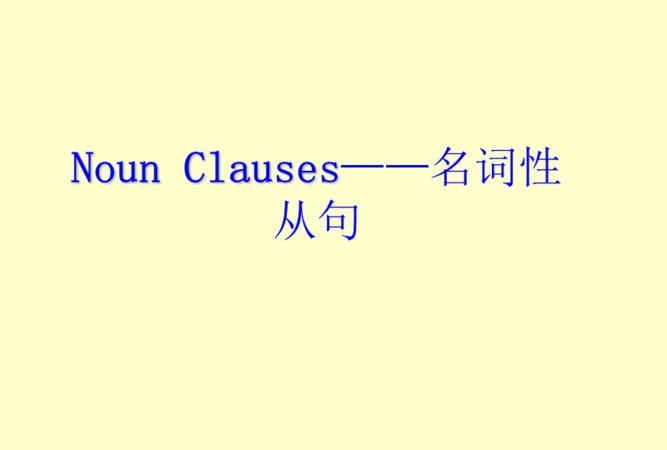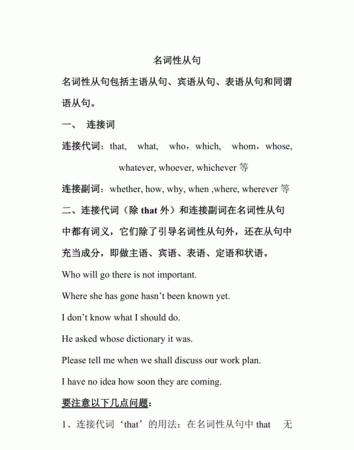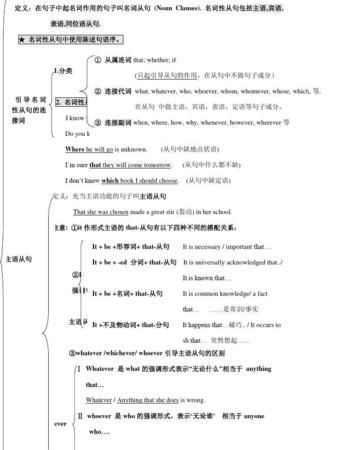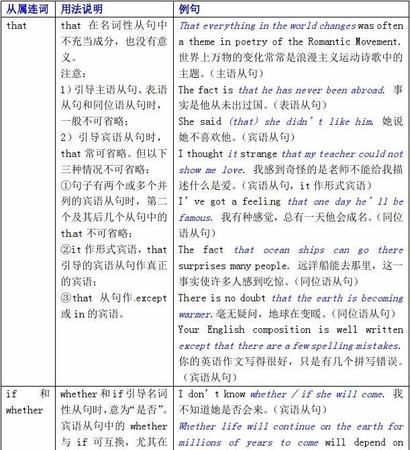本文目录
关于名词性从句的知识点
名词性从句是由if, whether, that 和各种疑问词充当连接词所引导的从句,其功同名词一样。
一.主语从句
主语从句是在复合句中充当主语的从句,通常放在主句谓语动词之前或由形式主语it代替,而本身放在句子末尾。
1. It 作形式主语和it引导强调句的比较
It 作形式主语代替主语从句,主要是为了平衡句子结构,主语从句的连接词没有变化。而it引导的强调句则是对句子某一部分进行强调,无论强调的是什么成分,都可用连词that。被强调部分指人是也可用who/whom。例如:
It is a pity that you didn’t go to see the film.
It doesn’t interest me whether you succeed or not.
It is in the morning that the murder took place.
It is John that broke the window.
2. 用it 作形式主语的结构
(1) It is +名词+从句
It is a fact that … 事实是…
It is an honor that …非常荣幸
It is common knowledge that …是常识
(2) it is +形容词+从句
It is natural that… 很自然…
It is strange that… 奇怪的是…
(3) it is +不及物动词+从句
It seems that… 似乎…
It happened that… 碰巧…
(4) it +过去分词+从句
It is reported that… 据报道…
It has been proved that… 已证实…
3. 主语从句不可位于句首的五种情况
(1) if 引导的主语从句不可居于复合句句首。
(2) It is said , (reported) …结构中的主语从句不可提前。例如:
It is said that President Jingo will visit our school next week. (right)
That President Jiang will visit our school next week is said. (wrong)
(3) It happens…, It occurs… 结构中的主语从句不可提前。例如:
It occurred to him that he failed in the examination. (right)
That he failed in the examination occurred to him. (wrong)
(4) It doesn’t matter how/whether …结构中的主语从句不可提前。例如:
It doesn’t matter whether he is wrong or not. (right)
Whether he is wrong or not doesn’t matter. (wrong)
(5) 含主语从句的复合句是疑问句时,主语从句不可提前。例如:
Is it likely that it will rain in the evening? (right)
Is that will rain in the evening likely? (wrong)
4. What 与that 在引导主语从句时的区别
What 引导主语从句时在句时在从句中充当句子成分,如主语.宾语.表语,而that 则不然。例如:
1) What you said yesterday is right.
2) That she is still alive is a consolation.
二.宾语从句
宾语从句就是在复合句中作宾语的名词性从句,通常放在主句谓语动词(及物动词)或介词之后。
1. 作动词的宾语
(1) 由that引导的宾语从句(that 通常可以省略),例如:
I heard that be joined the army.
(2) 由what, whether (if) 引导的宾语从句,例如:
1) She did not know what had happened.
2) I wonder whether you can change this note for me.
(3) 动词+间接宾语+宾语从句。例如:
She told me that she would accept my invitation.
2. 作介词的宾语
例如:Our success depends upon how well we can cooperate with one another.
3. 作形容词的宾语
例如:I am afraid (that) I’ve made a mistake.
That 引导的从句常跟在下列形容词后作宾语:
Anxious, aware, certain, confident, convinced, determined, glad, proud, surprised, worried, sorry, thankful, ashamed, disappointed, annoyed, pleased, hurt, satisfied, content 等。也可以将此类词后的that 从句的看作原因状语从句。
4. It 可以作为形式宾语
It 不仅可以作为形式主语,还可以作为形式宾语而真正的宾语that 从句则放在句尾,特别是在带复合宾语的句子中。 例如:
We heard it that she would get married next month..
5. 后边不能直接跟that 从句的动词
这类动词有Allow, refuse, let, like, cause, force, admire, condemn, celebrate, dislike, love, help, take, forgive等。这类词后可以用不定式或动名词作宾语,但不可以用that引导的宾语从句。例如:
I admire their winning the match. (right)
I admire that they won the match. (wrong)
6. 不可用that从句作直接宾语的动词
有些动词不可用于“动词+间接宾语+that从句“结构中,常见的有Envy, order, accuse, refuse, impress, forgive, blame, denounce, advise, congratulate等。例如:
He impressed the manager as an honest man. (right)
He impressed the manager that he was an honest man. (wrong)
7. 否定的转移
若主句谓语动词为Think, consider, wuppose, believe, expect, fancy, guess, imagine等,其后的宾语从句若含有否定意义,一般要把否定词转移到主句谓语上,从句谓语用肯定式。例如:
I don’t think this dress fits you well.(我认为这件衣服不适合你穿。)
三.表语从句
表语从句在复合句中作表语的名词性从句,放在系动词之后,一般结构是“主语+连系动词+表语从句”。可以接表语从句的连系动词有be, look, remain, seem等。引导表语从句的that常可省略。另外,常用的还有the reason is that… 和It is because 等结构。例如:
1) The question is whether we can make good preparation in such a short time.
2) This is why we can’t get the support of the people
3) But the fact remains that we are behind the other classes.
4) The reason he is late for school is that he missed the early bus.
四.同位语从句
同位语从句就是在复合句中作名词的同位语的名词性从句。
1. 同位语从句的功能
同位语从句对于名词进一步解释,说明名词的具体内容,一般由that引导,例如:
1) The king’s decision that the prisoner would be set free surprised all the people.
2) The order that all the soldiers should stay still is given by the general.
2. 同位语在句子中的位置
同位语从句有时可以不紧跟在它所说明的名词后面,而是被别的词隔开。例如:
He got the news from Mary that the sports meeting was put off.
3. 同位语从句与定语从句的区别
(1) 定语从句中的that既代替先行词,同时以在从句中作某个成分(主语或宾语),而同位语从句中的that是连词,只起连接主句与从句的作用,不充当句中任何成分。
(2) 定语从句是形容词性的,其功能是修饰先行词,对先行词加以限定,描述定的性质或特征;同位语从句是名词性的,其功能是对名词进行补充说明。例如:
1) The news that he told me is that Tom would go abroad next year.(他告诉我的消息是汤姆明年将出国。)(第一个that引导的从句是定语从句,that在从句中作宾语)
2)The news that Tom would go abroad is told by him.(汤姆将出国的消息是他讲的。)(同位语从句,that在句中不作任何成分)

名词性从句语法知识点
定语从句是由关系代词和关系副词引导的从句,其作用是作定语修饰主句的某个成分,定语从句分为限定性和非限定性从句两种。状语从句分为时间状语从句,结果状语从句,让步状语从句,原因状语从句,条件状语从句以及行为方式状语从句。名词从句包括主语从句,宾语从句,表语从句和同位语从句及there be句型。
一、 限定性定语从句
1. that即可代表事物也可代表人,which代表事物;它们在从句中作主语或宾语,that在从句中作宾语时常可省略关系词,which在从句中作宾语则不能省略。而且,如果which在从句中作“不及物动词+介词”的介词的宾语,注意介词不要丢掉,而且介词总是放在关系代词which的前边,但有的则放在它原来的位置
2. which作宾语时,根据先行词与定语从句之间的语义关系,先行词与which之间的介词不能丢
3. 代表物时多用which,但在带有下列词的句子中用that而不用which,这些词包括all, anything, much等,这时的that常被省略
4. who和whom引导的从句用来修饰人,分别作从句中的主语和宾语,whom作宾语时,要注意它可以作动词的宾语也可以作介词的宾语
5. where是关系副词,用来表示地点的定语从句
6. when引导定语从句表示时间
〔注〕值得一提的是,表示时间“time"一词的定语从句只用when引导,有时不用任何关系代词,当然也不用that引导
By the time you arrive in London, we will have stayed there for two weeks.
I still remember the first time I met her.
Each time he goes to besiness trip, he brings a lot of living necessities, such as towers, soap, toothbrush etc.
7. whose是关系代词,修饰名词作定语,相当于所修饰成分的前置所有格
8. 当从句的逻辑主语是some, any, no, somebody, anybody, nobody, something, anything, everything或nothing时,常用there is来引导
二、非限定性定语从句:非限定性定语从句的作用是对所修饰的成分作进一步说明,通常和主句间用逗号隔开,将从句拿掉后其他部分仍可成立
1. which引导的非限定性定语从句来说明前面整个句子的情况或主句的某一部分
2. 在引导限定性定语从句时,that有时相当于in which, at which, for which或at which
Attitudes towards daydreaming are changing in much the same way that(in which) attitudes towards night dreaming have changed. 人们对白日做梦的态度正在改变,这与人们对夜间做梦的看法的变化有非常相似之处。
I like the music for the very reason that(for which) he dislike it. 我出于某种原因喜欢这种音乐,而他恰恰与我相反。
We arrived the day that(on which) they left. 刚好我们到的那天他们走了。
3. 有时as也可用作关系代词
4. 在非限定性定语从句中,不能用that,而用who, whom代表人,用which代表事物
同位语从句指的是从句在复合句中作同位语,它是同位语的一种表现形式。这种作同位语的从句看起来似乎并不复杂,但在阅读和翻译中,如果我们缺少对它的分析,就有可能造成误解。现将这种从句分析如下:
A.同位语从句的实质
从句作同位语表示与之同位的名词(短语)的实际内容,它的作用相当于名词,对前面的名词(短语)加以补充说明或进一步解释,相当于一个表语从句,它们之间的关系是同位关系,即主表关系。如果用变通的办法,把名词(短语)和“主语+be+表语”结构联系起来,就可以看出这种同位关系。试比较:
We all know the theory that matter is made up of atoms and molecules. (=We all know the theory, and the theory is that matter is made up of atoms and molecules.) 我们大家都知道物质是由原子和分子构成的这一理论。
The suggestion that we should develop the natural resources in the region has been discussed.(=The suggestion is that we should develop the natural resources in the region, and the suggestion has been discussed.)关于我们应该开发本地区资源的建议已经讨论过了。
The problem whether natural rubber is a polymer with linear chain molecules has been solved.(=The problem is whether natural rubber is a polymer with linear chain molecules, and the problem has been solved.)天然橡胶是否是线型链状分子的聚合物,这个问题已经解决了。
I have no idea when she will be back.(=I have to idea, and the idea is when she
will be back.)我不知道她什么时候会回来。
B.引导同位语从句的连接词
引导同位语从句的连接词最常见的是that。That是一个纯引导词(pure introductory word),在同位语从句中常可省去,尤其是在口头语中。例如:
I had the impression (that)your government was undecided about assisting us. 我的印象是,你们政府还没有决定援助我们。
“Billing and cooing! That's the way (that) you think of it! That's the way (that) you talk of it!
As though it were something you had to do.”“谈情说爱!这是你的想法!这是你的说法!仿佛这是你的义务似的”。
连接词when, where, why, whether, how 等也可引导同位语从句,这些连接词除有连接主句和同位语的语法功能外,还有一定的“疑问”意义。例如:
He has solved the question why he is ill. 他已经解决了他为什么生病的问题。
Have you any idea how fast sound travels? 你知道声音传播有多快吗?
连词but that 也可引导同位语从句,人它通常出现在“否定词+doubt (deny, question)等名词”结构之后。这时,but 无否定含义,仅起强调作用,常可省去;有时也可省去that而保留but。例如:
There is no question (but) that the four modernizations will be realized in China by the end of the century. 中国在本世纪内实现四个现代化,这是没有问题的。
There is no doubt but (that) we will succeed in designing the project.毫无疑问,我们能把这项工程设计出来。
C.同位语从句的先行词
同位语从句的先行词通常是抽象名词,常见的有:idea, situation thought, fact, evidence, belief, doubt, fear, hope, question, theory, news, order, ability等等。例如:
Wives lived in fear that their husbands might be killed. 妻子们担心丈夫会战死,
提心吊胆地过日子。
How did the cheats explain the fact that the Emperor didn't feel the new clothes in him? 皇帝觉得身上并没有穿上新衣,对这个问题骗子是怎样解释的?
Is there any reason that he chose that honest old prime minister to go and find out? 他挑选那位诚实的老宰相去了解真相,有什么缘故吗?
代词it可用作同位语从句的先行词。这个it常放在某些动词或短语动词后作宾语,同时兼作其后that同位语从句的先行词。例如:
We take it that you will act according to the final agreement. 我们认为你方是会按照最后协议行事的。
In measuring electromotive force with a voltmeter, we should see to it that the
voltmeter is placed in parallel with the electric source. 用伏特计测量电动势时,
务必使伏特计与电源并联。
I owe it to you that I am still alive. 幸亏你,我现在还活着。
有的语法学家把先行词it后的that从句看作是动词或介词的真正宾语。我们认为,这种it后的that 从句应看作it的同位语,因为它相当于“主语+be+表语”结构。试比较:
You must se to it that the children don't catch cold.(=You must see to it, and I
t is that the children don't catch cold.)你要当心,别让孩子们着凉了。
D.“复合介词+the fact+that从句”结构从总体来看,这种结构属介词短语。如果分开来理解,其中的the fact 用作复合介词的宾语,同时兼作其后that从句的先行词,that从句为同位语从句。例如:
It is chiefly due to the fact that the sun gets higher in the sky in summer and
shines more directly down on that part of the earth.
这主要是由于夏天太阳在空中的位置较高,同时更加直接地照射着地球的那一部分。
We must never overlook our small weak points because of the fact that we have ma
de big achievements. 我们不可因为有了大的成绩就忽视小的缺点。
Owing to the fact that I had lost his address, I didn't know where I could find
him.由于我把他的地址遗失了,所以我不知到哪里去找他。
这种结构中的复合介词很多,常见的有:due to, by dint of, by virtue of, because of, on account of, in view of,等等。
E.同位语从句与先行词之间的分隔同位语从句一般都紧跟在与其同位的名词(即先行词)之后,但当先行词作句子的主语,其谓语较短,同位语较长时,同位语从句常与同位名词(短语)分隔。例如:
In the first half of the last century the discovery was made that a magnet could
be used to get an electric current. 上个世纪的前半期,发现可用磁铁产生电流。
The boy bore up well when the news came that his father had been killed. 当消息
传来,说他父亲牺牲时,这孩子表现得很坚强。
The theory is of great importance that the hotter a body is, the more energy it
radiates. 物体的温度愈高,放射的能量愈多,这一理论非常重要。
当前一同位成分的名词中心词(即先行词)有后置修饰语(如短语或定语从句等)时,同位语从
句常可能远离其先行词。例如:
For example, we know that the statement commonly accepted when the first edition
of this book was printed, that life was altogether absent in the deeper parts of the sea, is not true. 例如,在海洋深处完全没有生命这一说法,在本书第一版付印时
是人们所公认的,但现在我们知道这并不正确。
An indistinct idea he had, that the child was desolate and in want of help.他心
里有一种模糊的概念,就是这孩子是无人照顾的,需要帮助。
如何区别定语从句与同位语从句(一)
同位语从句和定语从句从表面来看十分相似,但实质上是截然不同的两种从句:
(1)同位语从句所修饰的词是有限的一些抽象名词,而定语从句就没有这种限制。
同位语从句经常用于下列有限的几个词后: hope(希望),idea(想法), news(消息), order(命令), fact(事实), question(问题),reason(理由),belief(相信),doubt(怀疑),evidence(根据),conclusion(结论),truth(真理),result(结果)等。
(2)句法功能不同。
同位语从句同它所修饰的名词在内容上是等同关系,在句中的语法作用处于同等地位。而定语从句说明前一名词的性质、特征,对先行词进行修饰、限制,是先行词不可缺少的定语。
(3)引导词that在同位语从句中不作句子成分;而在定语从句中必作句子成分,是从句所修饰的词的替代词。试比较:
The fact that the Chinese people invented the compassis known to all.中国人发明指南针这个事实是众所周知的。(同位语从句)
The fact that we talked about is very important.我们谈论的这个事实很重要。(定语从句)
如何区别同位语从句和定语从句(二)
同位语从句和定语从句在形式上基本相同,都是跟在名词或代词之后,且又常由that引导。但它们的句法功能却是不同的,我们可以从三个方面来加以区别。
(1)根据that来区别。引导定语从句的that是关系代词,除了起连接主句和从句的作用外,还代替先行词在从句中充当一个成分。而且这个that还常可以用which来代替。引导同位语从句的that是个连词,只起连接主句和从句的作用,在从句中不充当任何成分,也不能用which来代替。例如:
The fact that(which) we talked about is very impor-tant.我们所谈论的那个事实很重要。(that在从句中作about的宾语)
The fact that he succeeded in the experiment pleasedeverybody.他实验成功这个事实使我们大家很高兴。(that只起连接作用)
再如:
The news that you heard is true.你听到的消息是真的。(that在从句中作heard的宾语)
Here comes the news that some tourists from Americawill come to our village.消息传来,说一些美国旅游者要来我们村。(that只起连接作用)
(2)根据先行词来区别。
定语从句的先行词可以是人,也可以是具体事物或抽象概念。定语从句在复合同中相当于形容词,对这些先行词起修饰、描述或限制的作用。例如:
The moon is a satellite that goes around the earth.月亮是围绕地球运转的一颗卫星。
The few points that the president stressed in his reportare very important.总统在报告里强调的几点确实很重要。
同位语所进一步说明的词则是抽象意义的概念,如:fact,result,discovery,news,hope,reason,proposal,thought等。同位语的作用相当于名词,对前面的名词给予补充说明或进一步解释。例如:
He has an idea that he can make the scientific instru-ment in a better way.他想到能用更好的方法制造这种科学仪器。(从句是idea的具体内容)
He expressed the hope that he would come to China a-gain.他表达了他要再来中国的希望。(从句是hope的具体内容)
(3)根据引导词来区别。
如果引导从句的词为when,where,why或者how,而其前面的名词又分别表示时间、地点、原因或方式方法等意义,则它们为关系副词,引导的是定语从句。例如:
I’ll never forget the day when I saw the Great Wall.我永远不会忘记我见到长城的那一天。
This is the room where Lu Xun once lived.这是鲁迅曾住过的屋子。
而这些连接副词与前面的名词意义不相关时,这些词便是连接副词,引导同位语从句前面的名词往往也是idea,truth,news等。例如:
The question when we will start the work is not decid-ed.我们何时开始工作的问题尚未决定。
You have no idea how worried I was.你不知道我是多么担心。

名词性从句的分类及用法
名词性从句用法详解
来源:英语语法网
一、概说
名词性从句,即指性质相当于名词的从句,它包括主语从句、宾语从句、表语从句和同位语从句.从高考的考查的实际情况来看,名词性从句考得最多的是宾语从句,其次是主语从句,再次是表语从句,而同位语从句则很少考查.
二、名词性从句的一般引导词
1. 连接词 that 只起连接作用,没有任何意思,也不充当句子成分,在宾语从句中可省略,但引导其他名词性从句时通常不省略.如:
I hope (that) you enjoy your holiday. 希望你假期过得好.
That he likes you is very obvious. 很显然他喜欢你.
2. 连接词 whether 也不充当句子成分,但有自己的意思,表示“是否”;引导宾语从句时,可换成 if,但引导其他名词性从句时不能换成 if.
He asked whether [if] I would show him the way. 他问我是否可以给他带路.
Whether it will do us harm remains to be seen. 是否对我们有害还要看一看.(引导主语从句,不能用 if 代替 whether)
3. 连接代词 who(m), whose, which, what 等,均有各自的意义,在从句中作主语、宾语、定语等.如:
That’s why she wanted to leave. 这就是她想离开的原因.
When we arrive doesn't matter. 什么时候到没有关系.
Tell me which one you like best. 告诉我你最喜欢哪一个.
4. 连接副词 when, where, why, how 等,也各自有自己的意义,在从句中作状语.如:
The question is how we should carry out the plan. 问题是怎样执行这个计划.
When she’ll be back depends much on the weather. 她什么时候回来在很大程度上要看天气.
Why he did it will remain a puzzle forever. 他为什么这样做将永远是一个谜.
三、名词性从句的重要引导词
1. what 用于引导名词性从句是一个十分重要的引导词,它可引导主语从句、宾语从句和表语从句,但不用于引导同位语从句.它引导的名词性从句有两个意思是:一是表示“什么”,带有疑问意味;二是表示“…所…的”,相当于一个先行词后接一个关系代词.如:
I don’t know what you want. 我不知道你想要什么.
I don’t know what you want is this. 我不知道你所想要的是这个.
2. what 引导名词性从句时可用作限定词,其后修饰名词.如:
I gave him what books I had. 我把我所有的书都给他了.
He gave me what money he had about him. 他把身边带有的钱全给了我.
注:what 后的名词可以是复数名词或不可数名词,但通常不能是单数可数名词,并且后接不可数名词时,有时可有little修饰,两者的区别是:what+不可数名词=所有的都,what little+不可数名词=虽少但全部.如:
What friends she has are out of the country. 她有的那些朋友全在国外.
We gave him what (little) help we could. 我们给了他我们力所能及的帮助.
3. whoever, whatever, whichever 等也可引导名词性从句,其意分别为“所…的一切事或东西”、“任何…的人”、““…的任可人或物”等.如:
Whoever wants the book may have it. 任何人要这书都可拿去.
I’ll do whatever I can to help him. 我们将尽我们所能来挽救他.
Buy whichever is cheapest. 买最便宜的.
注意以下受汉语意思影响而弄错的句子:
任何人来都欢迎.
误:Who comes will be welcome. / Anyone comes will be welcome.
正:Whoever comes will be welcome. / Anyone who comes will be welcome.
另外,它们也可引导让步状语从句,其意为“无论…”、“不管…”,其意相当于 no matter who [what, which].如:
Whatever happens, you must be calm. 不管发生什么情况,你都必须镇静.(whatever = no matter what)
He won't eat you, whoever he is. 不管他是谁,他也不能把你吃掉.(whoever = no matter who)
注:whoever 既用作主格也用作宾语;作宾语时不宜用 whomever,因为在现代英语中 whomever 这个已几乎废弃不用.
4. why 与 because 的用法区别.两者均可引导表语从句,但前者强调结果,后者强调的原因.如:
I had a cold. That’s why I didn't come. 我感冒了,因此我没来.
I didn’t come. That’s because I had a cold. 我没有来,那是因为我感冒了.
五、名词性从句的语序
名词性从句的词序与陈述句语序相同,尤其注意那些由连接代词who(m), whose, which, what 和连接副词 when, where, why 等引导的名词性从句,不要受它们在特殊疑问句中用法的影响而误用疑问句词序.如:
Why was she crying? 她为什么在哭?
I don’t know why he was crying. 我不知道她为什么哭.
六、名词性从句的时态问题
1. 当主句的谓语动词是过去式时,宾语从句若不是一个客观事实或真理,其谓语动词也必须用某种过去时态.如:
She said that she didn't want to know. 她说她不想知道.
I asked her whether she would agree. 我问她是否会同意.
2. when, if 这两个词既可引导名词性从句,也可引导状语从句.当它们引导名词性从句且表示将来意义时,要直接使用将来时态;但当它们引导状语从句且表示将来意义时,则必须用一般现在时表示将来意义.如:
I don’t know when he will come, but when he comes, I’ll call you. 我不知道他什么时候,但当他来的时候,我会打电话给你.
句中第一个when 引导的是宾语从句,故用将来时态表示将来意义;第二个when 引导的是时间状语从句,故用一般现在时表示将来意义.

名词性从句是什么时候学的
一、引导名词性从句的连接词引导名词性从句的连接词可分为三类:连接词:that,whether,if
不充当从句的任何成分)连接代词:what,whatever,who,whoever,whom,whose,which.连接副词:when,where,how,why
不可省略的连词:1.介词后的连词2.引导主语从句和同位语从句的连词不可省略.That
she
was
chosen
made
us
very
happy.We
heard
the
news
that
our
team
had
won.比较:whether与if
均为"是否"的意思.但在下列情况下,whether
不能被if
取代:1.whether引导主语从句并在句首2.引导表语从句
3.whether从句作介词宾语4.从句后有"or
not"
Whether
he
will
come
is
not
clear.大部分连接词引导的主语从句都可以置于句末,用
it充当形式主语.It
is
not
important
who
will
go.It
is
still
unknown
which
team
will
win
the
match.

以上就是关于名词从句语法内容 ,关于名词性从句的知识点的全部内容,以及名词从句语法内容 的相关内容,希望能够帮到您。

